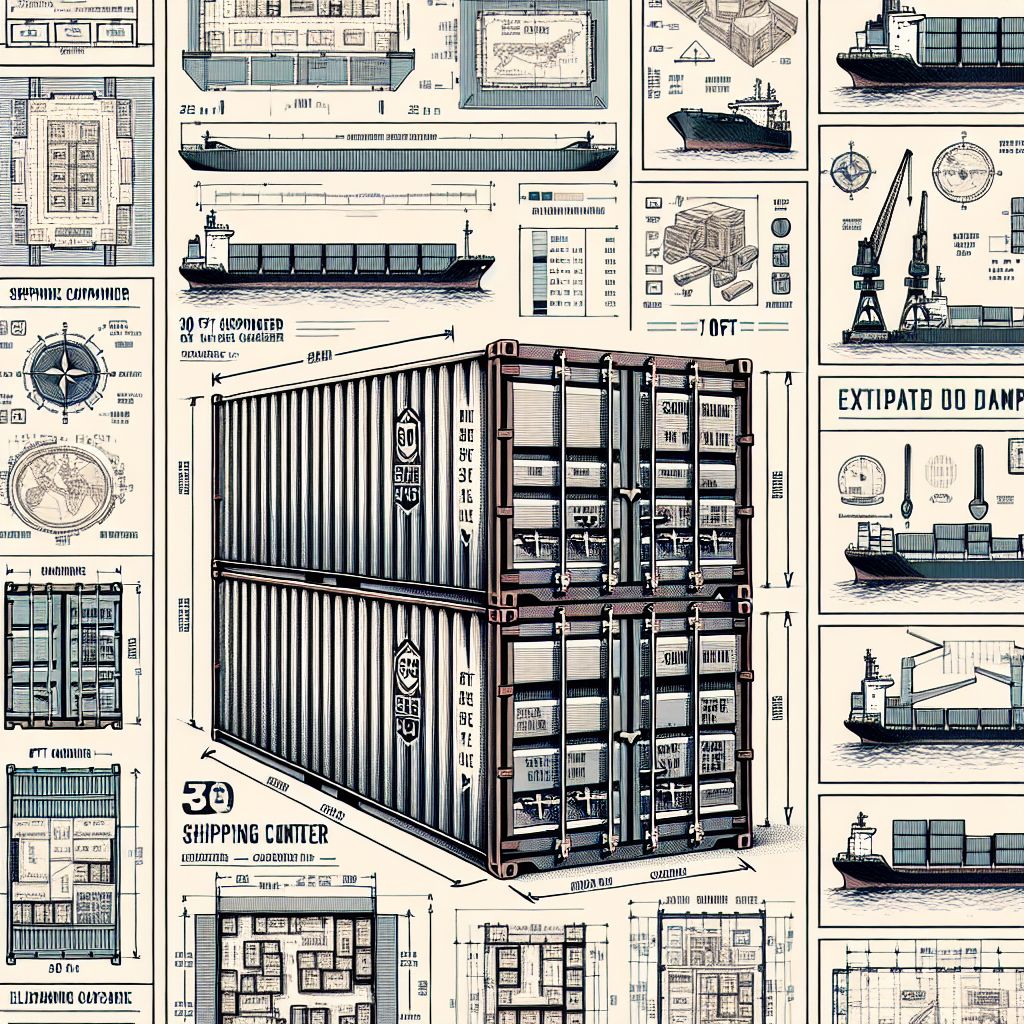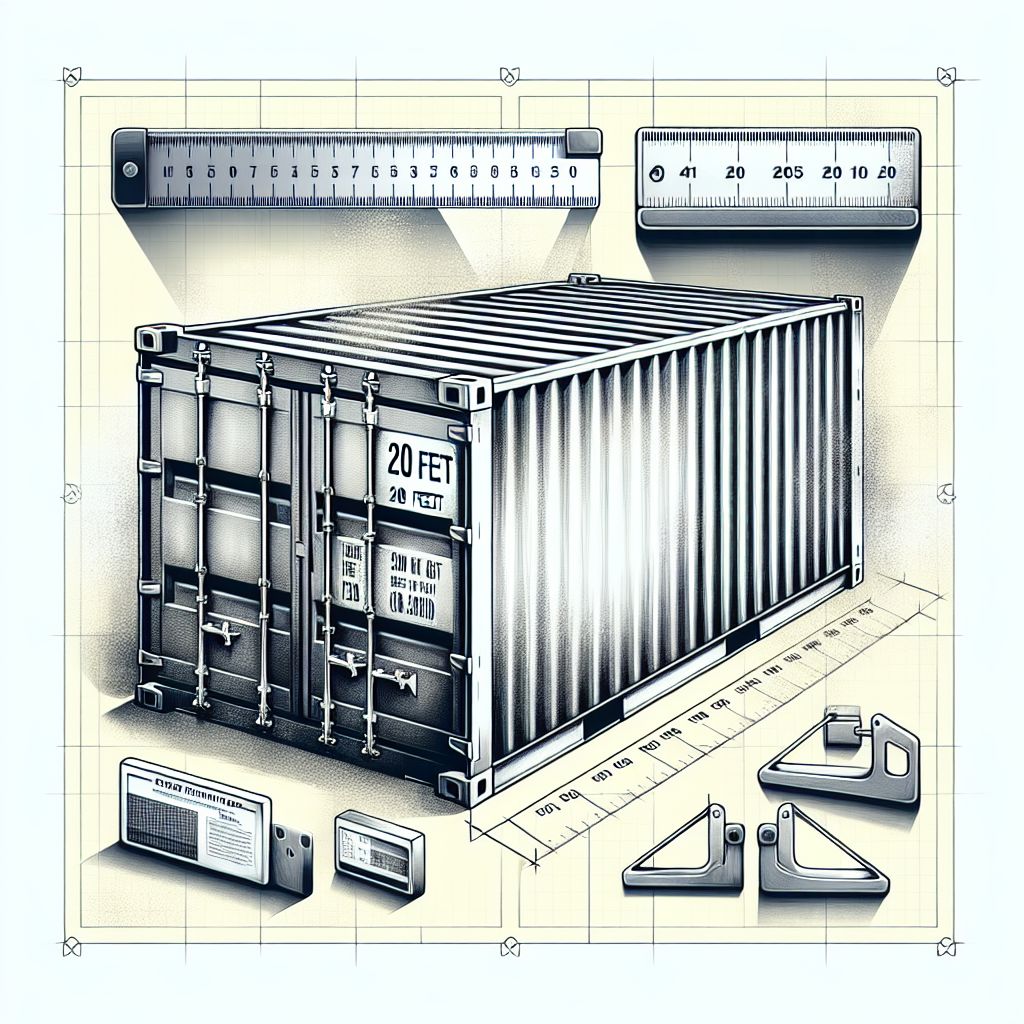
Key Takeaways
- A 30ft shipping container typically measures about 9.12 meters (30 feet) in length, 2.44 meters (8 feet) in width, and has a height of 2.59 meters (8 feet 6 inches) for standard containers and 2.89 meters (9 feet 6 inches) for high cube containers.
- The internal dimensions are slightly less due to the thickness of the walls, affecting the total usable volume, which is an important consideration for load planning.
- Knowing the net weight and the maximum contents weight is crucial for logistics planning to avoid overloading and to ensure safe and cost-effective shipping.
- Optimizing the use of a 30ft container can lead to significant savings in shipping costs and increased efficiency in the logistics chain.
- Comparing different container sizes and understanding their specifications can help businesses make informed decisions on the best type of container for their needs.
Cracking Open the 30ft Shipping Container
Imagine a metal box that’s as long as a giraffe is tall. That’s your 30ft shipping container. It’s a staple in the shipping industry, striking a balance between space and maneuverability. Whether you’re shipping furniture, machinery, or your entire home, understanding the dimensions and capabilities of this container is key to planning your logistics effectively.
Why Size Matters in Global Trade
Size isn’t just a number—it’s the difference between a smooth shipment and a logistical nightmare. In the world of cargo transport, every inch and pound counts. That’s because the size of your container determines how much you can ship, how you can ship it, and even where you can ship it to.
My Favorite Container Homes Resource
I compared the top 3 Container Home Guides
to discover the ultimate resource!
See my top recommendation here
30ft Container: The Sweet Spot in Shipping
Why go for a 30ft container? Well, it’s like the middle child—it’s not too small that it lacks space, and not too large that it’s cumbersome. It’s just right for those shipments that need a little more room than a 20ft container but don’t require the vastness of a 40ft one. Plus, its dimensions are friendly for both land and sea transport, making it a versatile choice for shippers.
Decoding Container Dimensions
Let’s dive into the nitty-gritty. When we talk about container dimensions, we’re dealing with two sets of numbers: external and internal. The external dimensions are important for fitting the container in ships, trucks, and cargo holds, while the internal dimensions tell you how much space you have to work with for your goods.
External Dimensions: The Big Picture
The 30ft container’s external dimensions are pretty standard. They’re designed to fit neatly in cargo holds and on transport vehicles. But don’t be fooled by the uniform exterior—variations like the high cube containers offer extra height for taller cargo.
But let’s not forget that these steel boxes have to travel through a world of different infrastructures. From the width of roads to the height of bridges, the external dimensions of your container can dictate the route your shipment takes.
Internal Dimensions: The Space You Can Use
Inside, the 30ft container is spacious enough to pack in a substantial amount of goods. It’s the internal dimensions that will interest you the most because they directly impact how much you can ship. Remember, the walls and doors of the container take up space, so the internal length, width, and height will always be a tad less than the outside.
Understanding Container Volume
The usable volume is where things get interesting. This is the amount of space available for your cargo, and it’s measured in cubic feet or cubic meters. The higher the number, the more you can fit in. Think of it like a giant 3D puzzle, where you’re trying to fit as many items as possible without wasting space.
And why is volume such a big deal? Because wasted space is wasted money. If you’re not maximizing the volume of your container, you’re essentially throwing cash into the sea.
- Usable volume is key for maximizing shipping efficiency.
- Maximizing container volume can lead to significant cost savings.
- Wasted space in shipping is equivalent to wasted money.
Door Aperture: Entry and Exit Points
The door aperture, or the size of the container’s door, is another critical dimension. It has to be wide and tall enough to load your cargo easily. If the door’s too small, you might have to say goodbye to that oversized piece of equipment you were hoping to ship.
Weight Limits and Impact on Shipping Efficiency
Now, let’s tackle weight limits. It’s not just about how much space you have, but also how heavy your cargo can be. The weight of the cargo influences fuel consumption, shipping costs, and even the modes of transportation available to you. It’s essential to get this right to avoid overloading and potential penalties.
Overloading not only risks safety but can also lead to hefty fines and delays. It’s like trying to fit all your groceries into one bag. If you overdo it, the bag rips, and your groceries are all over the floor. Not a good situation, right? The same principle applies to shipping containers.
Net Weight: What You’re Working With
The net weight of a container refers to the weight of the container itself without any cargo. It’s like the weight of an empty suitcase before you pack it for a trip. For a 30ft container, the net weight is usually around 2,870 kilograms (6,330 pounds), but this can vary depending on the manufacturer and the specific design of the container.
Understanding the net weight is crucial because it helps you calculate the total weight you’ll be moving. This is important when you’re coordinating with transportation companies, who need to know this information to ensure they comply with road weight regulations.
- Net weight helps in planning and adhering to transport regulations.
- Knowing the net weight is essential for total weight calculation.
- Transport companies require accurate weight information for compliance.
When planning your load, always start with the net weight and then add the weight of your cargo. This way, you’ll have a clear picture of the total weight and can avoid any nasty surprises when it’s time to ship.
Max Contents Weight: How Much Can You Ship?
The max contents weight, also known as the payload capacity, is the maximum weight of the cargo that the container can safely carry. For a 30ft shipping container, this is typically around 28,200 kilograms (62,170 pounds). This is the number that tells you how much your shipment can weigh to be transported safely and legally. For more details on container sizes and their capacities, check out this size and weight guide.

Translating Container Specs into Business Benefits
Knowing your container’s specs isn’t just for logistics geeks—it’s a business advantage. When you understand the dimensions and weight limits, you can plan better, save money, and avoid logistical headaches. It’s like having a map in a maze; it guides you to the best path forward.
For instance, if you know your container can handle a certain weight, you can pack it accordingly to maximize space and minimize shipping costs. This is particularly useful when you’re shipping heavy items like machinery or construction materials.
And it’s not just about what you’re shipping, but how you’re shipping it. Different containers might be better suited for different types of cargo. For example, high cube containers are perfect for tall items, while standard containers might be better for heavier, more compact goods.
Optimizing Load Planning
Load planning is like a game of Tetris. You want to fit everything in the most efficient way possible. With a 30ft container, you have a lot of room to play with, but you also need to be smart about how you use it.
Effective load planning means considering the dimensions and weight of your cargo, as well as the sequence in which you’ll load and unload it. You need to balance the load to prevent shifting during transport, which can be dangerous and costly.
Cost Considerations and Container Choice
Cost is always a factor in shipping, and choosing the right container can make a big difference. A 30ft container can be more cost-effective than a larger one if you don’t need the extra space. It’s about paying for what you need, not what you don’t.
Also, remember that shipping rates can vary based on the weight and volume of your cargo. By optimizing the use of a 30ft container, you might be able to ship more for less, especially if you’re clever about packing and stacking your goods.
Comparisons and Context
So, how does a 30ft container stack up against other sizes? It’s all about context. For some shipments, a 20ft container will do just fine. But for others, you might need the extra space that a 30ft container provides.
Taller, Shorter, Longer: Comparing Container Sizes
Containers come in various sizes, each with its own set of advantages. The 20ft container is great for smaller shipments or heavy goods that need a compact space. The 40ft container is the go-to for large, bulky items or when you’re moving a lot of stuff.
The 30ft container is the middle ground. It gives you more space than the 20ft without being as large and potentially unwieldy as the 40ft. It’s perfect for when you’re in that Goldilocks zone of shipping—not too much, not too little, just right.
30ft vs. 40ft Containers: When to Upgrade
Choosing between a 30ft and a 40ft container can be a tough decision. The key is to consider the nature of your cargo and your shipping needs. If you’re consistently maxing out a 30ft container, it might be time to consider upgrading to a 40ft for efficiency.
However, if you’re rarely filling up a 30ft container, sticking with it can save you money. It’s all about matching your container size to your shipping volume to avoid paying for unused space.
30ft Container Specification Table
| Size | External Dimensions (LxWxH) | Internal Dimensions (LxWxH) | Usable Volume | Net Weight | Max Contents Weight |
|---|---|---|---|---|---|
| 30ft Standard | 9.12m x 2.44m x 2.59m (30′ x 8′ x 8’6″) | 8.95m x 2.35m x 2.39m (29’4″ x 7’8″ x 7’10”) | 67.6m³ (2387ft³) | 2,870kg (6,330lbs) | 28,200kg (62,170lbs) |
| 30ft High Cube | 9.12m x 2.44m x 2.89m (30′ x 8′ x 9’6″) | 8.95m x 2.35m x 2.69m (29’4″ x 7’8″ x 8’10”) | 76.4m³ (2699ft³) | 2,870kg (6,330lbs) | 28,200kg (62,170lbs) |
References:
https://www.shippingcontainersuk.com/info/shipping-and-storage-container-dimension-charts.php
https://www.clevelandcontainers.co.uk/containers/30ft-containers
https://www.discovercontainers.com/shipping-container-dimensions/
https://www.lioncontainers.co.uk/30ft-storage-container-sales/

Frequently Asked Questions (FAQ)
What Is the Standard Height of a 30ft Container?
The standard height of a 30ft container is typically 2.59 meters or 8 feet 6 inches. However, for those who need extra height for taller cargo, the high cube version provides an additional foot, with a height of 2.89 meters or 9 feet 6 inches.
Can a 30ft Container Be Used for International Shipping?
Absolutely. The 30ft container is designed for both domestic and international shipping. Its dimensions conform to the standards set by the International Organization for Standardization (ISO), making it suitable for transport by road, rail, and sea.
- 30ft containers are ISO-compliant for international shipping.
- They are versatile for road, rail, and sea transportation.
How Does Container Volume Affect Shipping Costs?
Container volume directly impacts shipping costs because it determines how much cargo you can fit into a single container. The more you can fit, the more cost-effective your shipment becomes. If you don’t maximize the container’s volume, you may end up paying for unused space, which is inefficient and costly.
Are 30ft Containers Weatherproof and Secure?
Yes, 30ft containers are designed to be both weatherproof and secure. They are constructed from corrosion-resistant steel and have rubber seals around the doors to protect against the elements. Additionally, they come equipped with locking mechanisms that can be further secured with padlocks or seals for added safety.
Weatherproofing and security features include:
- Corrosion-resistant steel construction.
- Rubber seals around doors to prevent water ingress.
- Locking mechanisms for cargo safety and security.
What Are the Advantages of a High Cube 30ft Container?
The primary advantage of a high cube 30ft container is the extra height, which allows for taller cargo or more stacking of goods. This can be particularly beneficial for lightweight, voluminous cargo or when you need to maximize the space available for shipping. The additional height can also provide more air circulation, which is advantageous for certain types of cargo.






Leave a Reply